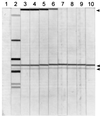Detection of multiple human papillomavirus types in Condylomata acuminata lesions from otherwise healthy and immunosuppressed patients
- PMID: 10488198
- PMCID: PMC85555
- DOI: 10.1128/JCM.37.10.3316-3322.1999
Detection of multiple human papillomavirus types in Condylomata acuminata lesions from otherwise healthy and immunosuppressed patients
Abstract
Condylomata acuminata, or genital warts, are proliferative lesions of genital epithelium caused by human papillomavirus (HPV) infection. HPV types 6 and 11 are most often detected in these lesions. Genital lesions consistent with exophytic condylomata acuminata were removed by excision biopsy from 65 patients, 41 of whom were otherwise healthy individuals (control group) and 24 of whom had conditions known to cause immunosuppression. Histologically, the majority of the lesions were typical condylomata acuminata. Three lesions removed from immunosuppressed individuals also contained foci of moderate to severe dysplasia (intraepithelial neoplasia grade II/III). A recently developed PCR and reverse blot strip assay was used to determine the specific HPV types present in the genital lesions. With a set of oligonucleotide primers based on the same primer binding regions used for the MY09 and MY11 primer pair, this PCR assay detects the presence of 27 HPV types known to infect the genital tract. All but two condylomata acuminata contained either HPV type 6 or 11. The predominant type in the lesions from control patients was HPV 6, while lesions from immunosuppressed types most often contained HPV 11. Condylomata acuminata from immunosuppressed patients contained significantly more overall HPV types than lesions from the control group. HPV types associated with an increased risk of dysplasia (high-risk types) were detected in 42 (64.6%) of the total of 65 specimens; 18 (43.9%) specimens were detected in the 41 otherwise healthy individuals, and 24 (100%) specimens were detected in the 24 immunosuppressed patients. HPV 16 was the most common high-risk type detected, found in 21 of 65 (32.3%) specimens. After HPV types 6 and 11, HPV types 53 and 54 were the most frequently detected low-risk HPV types. This study demonstrates that a high percentage of condylomata acuminata lesions contain multiple HPV types, including types associated with a high risk of dysplastic abnormalities. Further studies are needed to determine the influence these additional HPV types have on the epidemiology of genital tract HPV infections and the natural history of condylomata acuminata, especially in immunosuppressed patients.
Figures



References
-
- Beckmann A M, Sherman K J, Myerson D, Daling J R, McDougall J K, Galloway D A. Comparative virologic studies of condylomata acuminata reveal a lack of dual infections with human papillomavirus. J Infect Dis. 1991;163:393–396. - PubMed
-
- Bergeron C, Ferenczy A, Shah K V, Naghashfar Z. Multicentric human papillomavirus infections of the female genital tract: correlation of viral types with abnormal mitotic figures, colposcopic presentation, and location. Obstet Gynecol. 1987;69:736–742. - PubMed
-
- Brachman D G. Molecular biology of head and neck cancer. Semin Oncol. 1994;21:320–329. - PubMed
-
- Brown D R, Bryan J T, Cramer H, Katz B P, Handy V, Fife K H. Detection of multiple human papillomavirus types in condylomata acuminata from immunosuppressed patients. J Infect Dis. 1994;170:759–765. - PubMed
Publication types
MeSH terms
Grants and funding
LinkOut - more resources
Full Text Sources
Medical

